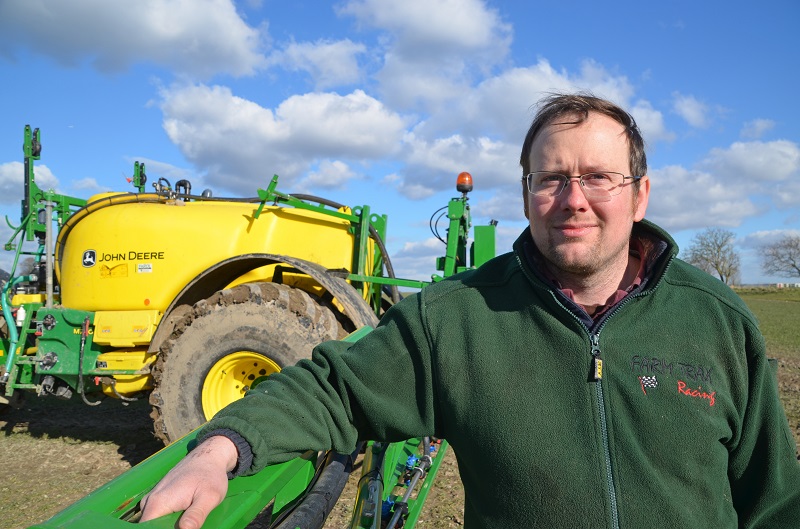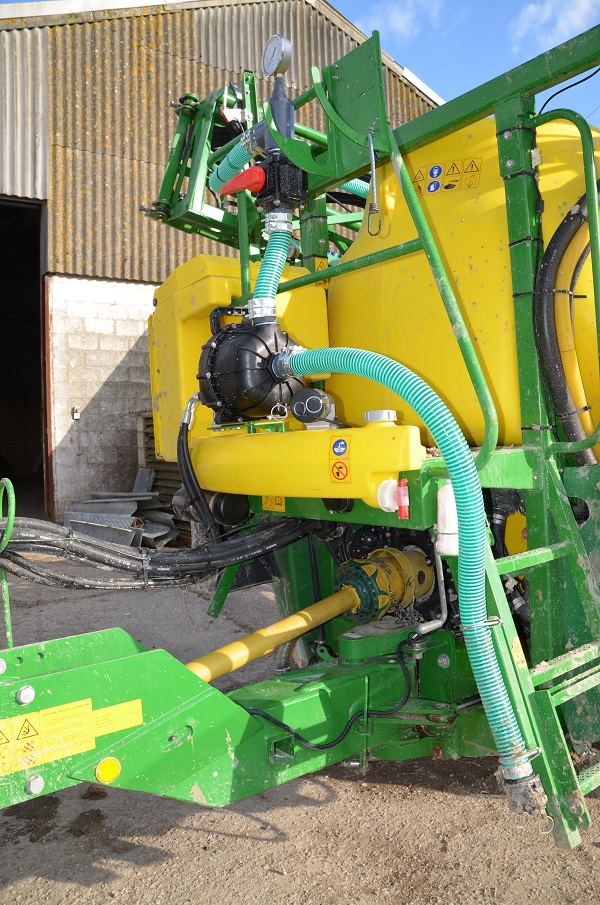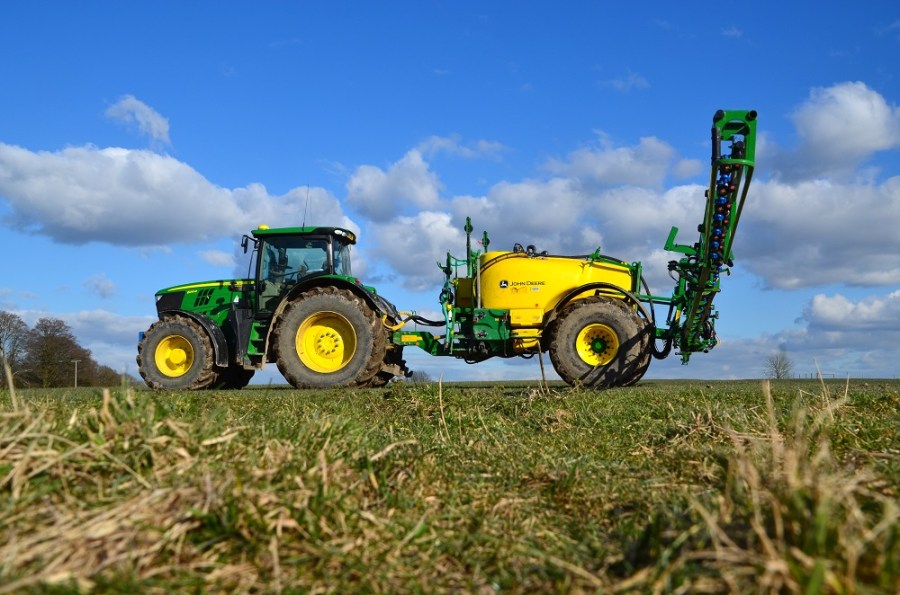Moving from a self-propelled sprayer to a trailed rig might be seen by some as a backward step. But for one Sussex grower it’s resulted in increased output and improved accuracy. CPM reports.
I wanted to upgrade to the latest technology to improve accuracy and make sure we were making the most of chemical efficacy.
By Nick Fone
Will Tupper is a man focused on efficiency. Growing 650ha of arable cropping plus a further 120ha of permanent pasture with 500 ewes running across it, he’s kept pretty busy.
Although he has help on the livestock side of things, he does all the drilling and spraying himself so the pressure can mount at busy times of the year.
“There are certain pinch points when the workload really starts to pile up,” he explains.“Because of that I need to

Will Tupper has seen output and accuracy improve massively by swapping his self-propelled sprayer to an ultra high-tech trailed machine with “all the toys”.
have kit that I can comfortably cover the ground with. On paper our machinery probably looks a bit over the top but it means we get things done in good time with minimal manpower.”
Extra output
Until two years ago the spraying was done by a 2007 Househam AR3000 with 24m booms but with the loss of a member of staff and the consequent need for extra output, the decision was made to go to wider tramlines.
“We’d been thinking about moving to 30m booms and switching from granular to liquid fertiliser.
“I also wanted to upgrade to the latest technology to improve accuracy and make sure we were making the most of chemical efficacy.
“We’d been suffering in that department with our old fixed-boom sprayer because we had to keep it high on our undulating downland to stop it clashing with the ground. That meant chemical wasn’t landing where it should and we weren’t getting the effectiveness we should – we needed variable geometry and auto height control.”

With an RTK-correction signal provided by the mobile phone network, John Deere’s auto-steering system provides inch-perfect positioning pass after pass.
So the search was on for a high-spec bells-and-whistles machine that met the Tupper criteria. However after a bit of research it became apparent that another self-propelled machine was going to be hard to justify.
“Replacing the Househam like-for-like was going to cost a huge amount. We just couldn’t stretch to it but we had to do something,” says Will Tupper.
“Searching for a more affordable option, I started to question why we needed a self-propelled machine. We’d had a Knight front and rear tank setup previously and crop clearance wasn’t that much of a problem later in the season but we needed more capacity.
“We’d run a Chafer trailed machine as our back-up for a while and I was happy with that format but just wanted more capacity and extra spec.”
So he started looking into the options more closely. Having had John Deere tractors for several years, the Tupper family had plenty of experience of the back-up from local dealer Farols. Consequently it was the green giant’s sprayers that were first in the firing line.
Tank size had to be 4000 litres to make a significant contribution to increasing output but any bigger and the weight would cause issues on the farm’s steep banks for the 210hp tractor that would act as tug for the new rig.
“First we looked at John Deere’s 900-series sprayers but they were significantly heavier so we opted for the lighter weight M740i.
“Being an ‘i-spec’ machine it has virtually all the extras you can hope for – critically including GPS section control which has been upgraded to RTK – but has a tracking drawbar instead of steering axle.”
It was the integration of Deere’s GPS steering and section switching that helped to clinch the deal. The sprayer is

The induction hopper drops almost to floor level – great for loading with powder, but not so good for lots of repetitive filling with small cans.
controlled via a Greenstar 2630 ISOBUS touchscreen which also takes the satellite position feed and uses a mobile network correction signal to provide RTK-level accuracy of between 2-5cm pass-to-pass. This means that not only is the tractor kept on track, but the boom’s ten 3m sections are switched on and off automatically as they pass over sprayed and un-sprayed areas of the field.
“The mobile RTK system has worked really well for us especially as we’re now trying to run repeatable tramlines year-on-year,” says Will Tupper.
“Previously we were running with a lot of drill overlap but that’s no problem now. It can lose signal for up to 15 mins and still maintains its accuracy so we haven’t really had any major problems with mobile reception.”
It’s no full-on controlled traffic system but Bignor Farms’ approach provides a practical compromise in minimising the impact of compaction from sprayers and spreaders. During harvest the Greenstar rig is moved over to the farm’s Claas Lexion 750 combine which works at 20° to the tramlines to spread the chaff evenly. Cultivations are then performed on the opposite 20° angle and the drill then runs back up the original mark.
Although the Greenstar system has worked well in providing automatic section control and placing the tramlines in the same place season after season, there’s one criticism for its performance on side slopes.
“With the receiver mounted on the tractor roof and the controller working to try and position the sprayer boom in the centre of each run, the tractor ends up running above the tramline wheelings when working across banks,” explains Will Tupper.
“I can’t understand why the tracking drawbar can’t be used to correct the natural crabbing of the sprayer without the expense of a second receiver to keep both the tractor and sprayer running neatly within the tramline.”
The sprayer’s performance on banks is his biggest gripe.
Steering axle
“Because we opted for the lighter M740i we couldn’t have the steering axle as we had on our old Chafer trailed machine.
“The tracking drawbar is nowhere near as good – it means we have to turn very steadily to stop the booms whipping and in the wet on a slope it can be lethal – it just wants to jack-knife all the time. The bigger tractor is essential, not only for its power but also for safety and traction.
“That said, when we originally looked around at trailed sprayers I thought the John Deere was the most stable machine on the market.”
That stability is brought about in part thanks to the decision to opt for a high-level wagon hitch. With the coupling set above the pto, it’s that much higher than a standard pick-up which Will Tupper believes adds to its surefootedness. Being hung rather than low-slung, it not only improves crop clearance, but also means the sprayer has less of a tendency to be top heavy. The set-up did provide an initial glitch however.
“We ordered the sprayer with a Schmarmuller ball-and-spoon coupling on the wagon hitch but found we had to run it on its highest setting to avoid it clashing with the pto. That meant the whole machine sat too high and ended up leaning back so we had to revert to a standard clevis and pin to get it running level.”
With that sorted, the M740i has otherwise performed faultlessly over the past two years. Having section control, digital tank level monitoring and GPS field-mapping means the spraying work is down to almost inch-perfect accuracy. With returns from the spraylines sent back to the suction side of the pump as the tank nears empty, there’s hardly ever more than 30 litres left after each block of crop is covered. It also means the pump is never drawing air, cavitating or losing pressure. However wash-outs aren’t quite as convenient as Will Tupper had hoped.
“Being an ‘i-spec’ machine, I can in theory set it to rinse out via the 2630 screen but the tiny electric clean water pump takes so long to draw through 350 litres of liquid that I’m better off to get out and do it the old fashioned way with the manual valves.
“On the boom I would have liked a rinse system that runs right to the nozzle bodies but the system on this machine just runs to the section valves so I have to draw through and squirt out some liquid to wash it through. At the time the full recirculating washout system wasn’t an option but, slightly annoyingly, I now understand it’s on the pricelist for M-series machines.”
For filling, the low-folding induction hopper is good for loading granular products and large containers but when there are multiple small cans all that stooping can bring on backache. That said, the sprayer’s ability to maintain rinse pressure when the hopper venturi is running is seen as a real strength.
“On all our previous machines you’d lose rinse pressure when you opened up the valve to empty the hopper. The way the John Deere is plumbed means it doesn’t suffer that issue and so you can properly clean out cans while loading the chemical.”
With turnaround times critical in maintaining sprayer output, this year Bignor Farms’ machine has had an upgrade to speed up filling with liquid fertiliser.
“Previously loading the 740i with 4200 litres of liquid took about 25 minutes. That’s fine when you’re busy adding chemical but when it’s a load of fertiliser you’re just stood about twiddling your thumbs.
“So this year we’ve had a 750-litre/min Hypro centrifugal fast-fill pump fitted that’s slashed fill times to about six minutes. It’s massively improved my output – I can easily do four loads in a morning when I would have done three before. With increasingly narrower spraying windows, that easily offsets the £1000 cost of the pump.”
Operational efficiency
To aid in increasing the sprayer’s operational efficiency, block cropping is now based around its capacity. With the arable ground spread fairly far and wide, crops are parcelled into blocks no bigger than 40ha so that one 4200-litre tankload (with plenty of ‘no-foam’) will do the lot at 100 l/ha. Any bigger areas have their own water supply so that a return trip to the yard isn’t required.
To further stretch the M740i’s working abilities into the night it was ordered with John Deere’s boom lighting system but it didn’t quite come up to scratch, says Will Tupper.
“To be honest, the worklights were hardly better than candles. You couldn’t physically see the end of the boom let alone what the nozzles were doing.
“I’ve since swapped them for a pair of UTV Products’ £80 LED spotlights which are literally brilliant.”
Another useful add-on is a Vapormatic reversing camera mounted up high on the central boom frame. Primarily a safety feature for when running on the road, it has also proved its worth when backing up to telegraph poles and trees in the field. Plugged directly into the back of the 2630 Greenstar screen, the image it captures is displayed on one of the sprayer homepages.
With so much clever electronic gadgetry crammed onto one machine, is it really worthwhile?
“Having 1000 litres extra tank capacity and 30m booms have undoubtedly had a massive impact in upping output,” concludes Will Tupper.
“But it’s all the extra bits that mean we’re doing a much better job than ever before. The GPS technology and boom height control means we’re far more accurate and you can see that clearly with the liquid fertilser work.
“With no overlaps we no longer get any flat patches or yellow areas as we did previously. We have far more precision so we’re producing better crops and saving money.”
- Video – to see footage of the Tuppers’ sprayer in action from the air and other videos of the business’ machinery, log in to YouTube and search for Bignor Farms.
Farm facts
TR Tupper (Bignor Farms) near Chichester, West Sussex
- Farmed area: 810ha
- Cropping: Winter wheat 324ha, spring barley 120ha, oilseed rape 120 ha, winter linseed 40ha, spring linseed 40 ha, permanent pasture and woodland 160ha
- Soils: Predominantly chalk downland with clay caps plus lower lying areas of silty clay loams
- Elevation: 90-180m ASL
- Mainline tractors: John Deere 6210-R, 6170-R, 6930 and 6200
- Combine: Claas Lexion 750TT with 7.5m header
- Loader: Merlo P28.7
- Drill: Horsch 6m Sprinter
- Sprayer: 4000-litre John Deere M740i with 30m booms
- Staff: Will and Tom Tupper plus one other full-time and part-timers as required (incl. contract shepherd)




